Some gardeners consider shade a curse, but a landscape of mature trees is really an asset if you’re willing to work with it. Trees keep us cool in summer, cutting down on cooling costs, and deciduous trees let in light during winter. When their leaves drop, they reveal a sculpture of twigs, trunks and branches silhouetted against the sky. Trees make our homes, neighborhoods and cities cooler, greener and more livable, and they have a magic all their own. Rather than a burden keeping you from planting sun-loving plants, see them as a blessing that allows you to plant exquisite shade species.
Some of the most stunning landscape plants require shade, but even more important, gardening amid a glade is an opportunity to create an enchanting outdoor space that is not possible in any other context. Done right, a shade garden is not a dark, dreary environment; it is an epic, expansive space.
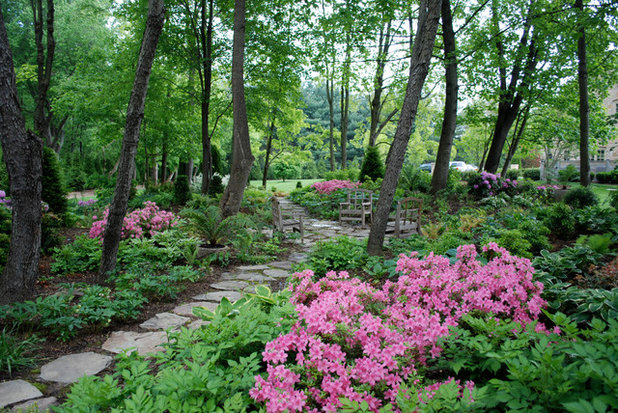
Sisson Landscapes
Make your space feel much larger than it actually is. An eighth-acre of forest feels much larger than 1 acre of open terrain because you can’t take it all in with one glance. Unlike gardens with full sun, you have to move through a shade garden to see it all. Here’s a second virtue to consider: A pathway through the woods beckons you precisely because you can’t see what’s at the end of it.
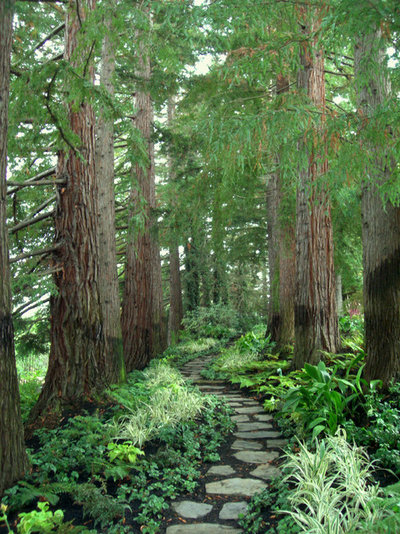
Zeterre Landscape Architecture
The psychology of the “disappearing path” is key to a shade garden. The subtle meander of the pathway in this garden amid a redwood forest makes you want to walk slowly through it, feeling present and observant of the immediate surroundings yet compelled by a mysterious force to see what’s around the bend. There is balance and symmetry here that isn’t forced — instead, it arises from how the trees naturally positioned themselves.
See 5 garden paths that inspire an enchanted journey
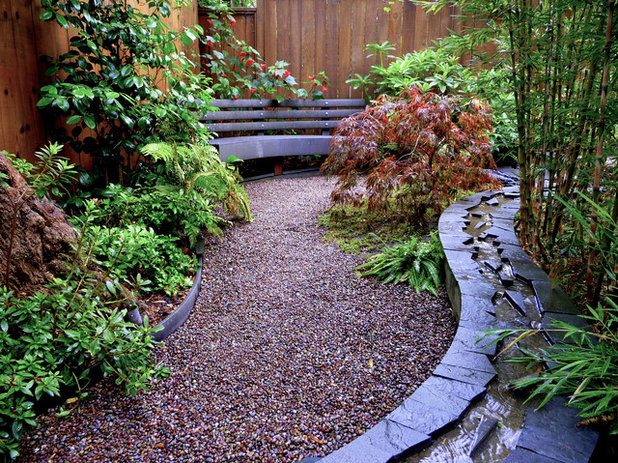
Sculpt Gardens Inc.
Conceal and reveal garden destinations. One timeless design technique that is well suited to shade gardens is known as conceal and reveal. The idea is to offer the viewers glimpses of their destination as they move through the space and then reveal it dramatically, all at once, when they turn a corner, go around a bend, enter a clearing or open a gate. The destination might be a water feature, a gazebo, a bench in a grassy clearing or a sunny space bursting with colorful wildflowers.
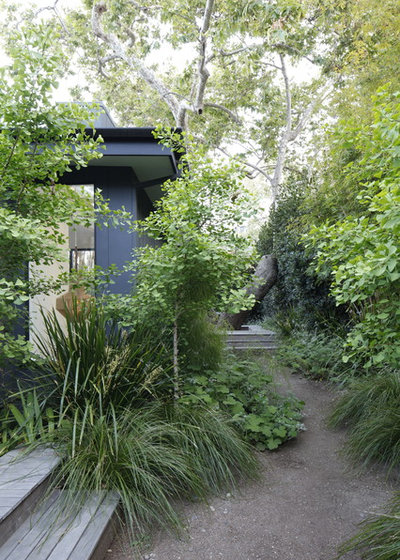
MTLA- Mark Tessier Landscape Architecture
Use plantings, shadows, fences and other structures to conceal the destination, but be sure there are views that perforate those objects periodically. The pathway itself is the main clue pointing the way, but also think about how other lines in the landscape converge in that direction. The angle of a tree trunk, a fence line or a row of red flowers can all conspire to draw the eye through the garden.
Add a hint of mystery to create a memorable garden
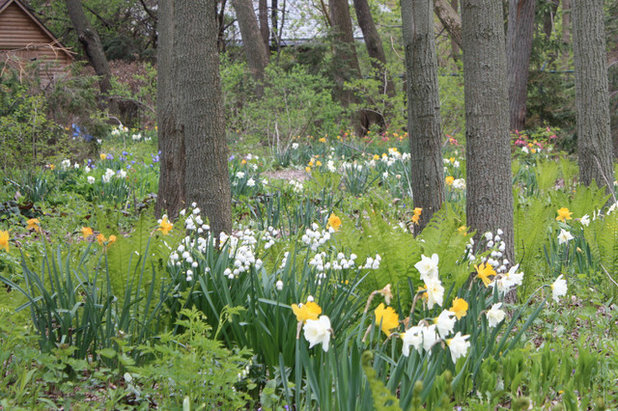
Rocco Fiore & Sons, Inc
Evoke different moods in different seasons. Where deciduous trees are used, a shade garden is truly shady for only part of the year. There is a large group of plants in natural deciduous woodlands, known as spring ephemerals, that erupt from the ground at the first hint of warm weather, when the forest floor is still bathed in light. They quickly flower, unfurl their leaves, set seed and, by midsummer, go dormant again. Many bulbs are in this category, some of which, like daffodils and snowdrops, can be naturalized on a large scale in open woodland gardens.
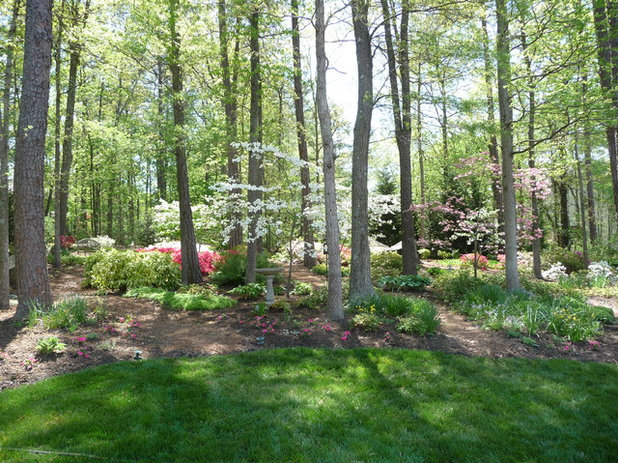
Gardens by Monit, llc
Ecologists like to say that the forest comes out of dormancy from the ground up. First, the tiny bulbs and herbaceous plants leaf out, followed by shrubs and small trees. The canopy is always the last to leaf out.
Dogwoods, fringetrees and serviceberry are some of the classic forest understory trees you can use to light up your shade garden in spring. It’s important to remove the lower limbs of taller trees so they don’t compete with understory plants, as well as to create an overall sense of spaciousness.
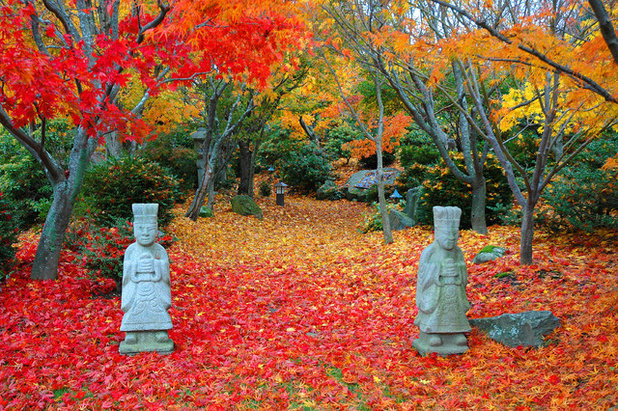
BAYBERRY NURSERIES
Few forest plants flower in summer, when the garden becomes a study in the color green. By fall, the hues change, and many of the plants at ground level become obscured by fallen leaves. A well-designed shade garden considers the seasonal variations and brings each into focus through the arrangement of plants and other features. Think of it not as one garden you are designing, but of four different gardens in the same setting.
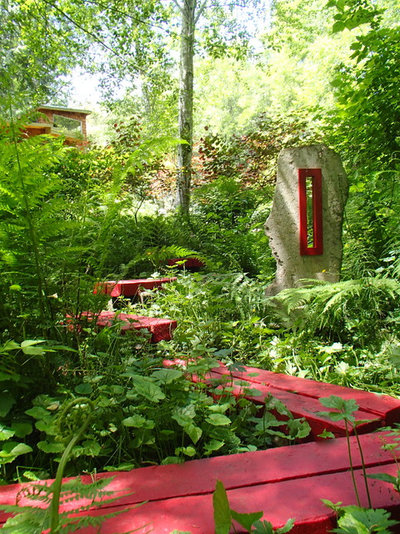
Aaron G. Edwards Landscape Architect
Contrast with color. For the most part, shade plants emphasize foliage more than flowers. The sea of green is soothing, but you can bring that quality into sharper focus with small doses of contrasting colors. That can occur seasonally, in the form of flowers or colorful foliage, but you can also knit the garden together year-round with a colorful hardscape element. Most shade gardens lack formality, leaving the path as the unifying theme visually. Carefully consider its movement through the space, and aim for a complementary contrast with the botanical elements, as with this red zigzag path.





